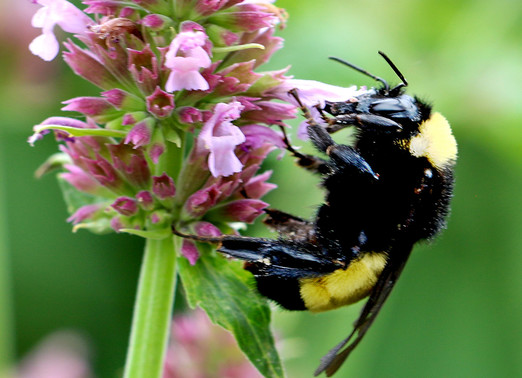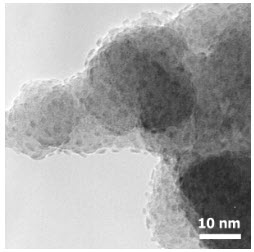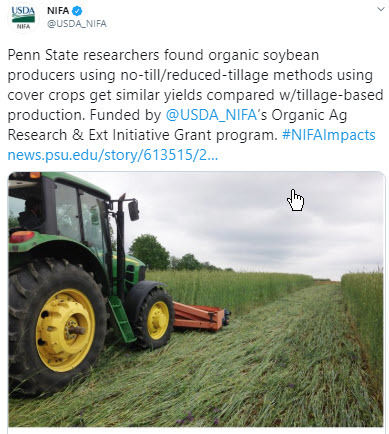|
Having trouble viewing this email? View it as a Web page.

|
|
|
Editor: Kelly Sprute April 1, 2020
Making a Difference
 Native plant garden mixes attract pollinators and beneficial insects. Image courtesy of Miranda Kersten NMSU.
Determining Combination of Native Flowers to Attract Different Pollinators
Pollinator insects play a critical role in the agricultural world. Without their natural transference of pollen from plant to plant while obtaining nutrients, many types of vegetables and fruit for human consumption would not exist. More than 80 percent of plants are pollinated by animals, mainly insects.
One area in which people can help support pollinator populations is by growing native flowering plants, from which the pollinators obtain protein and lipids from the pollen and carbohydrates and amino acids from the nectar.
Researchers at New Mexico State University’s (NMSU) College of Agricultural, Consumer and Environmental Sciences are studying the activity of insects, both pollinator and beneficial, around native plants to determine what mix of flowering cultivars will attract the different insect types. This study is supported by USDA’s National Institute of Food and Agriculture Extension Implementation Program grant.
When planning a pollinator garden, it is important to include plants that flower at different times of the season. Read the full NMSU article.
|
|

Yesterday, NIFA published a set of frequently asked questions regarding new agency flexibilities that may help our partners cope with current social distancing efforts taking place across the country. The document states that awardees are authorized to continue to charge salaries, stipends, and benefits to currently active USDA NIFA awards consistent with the recipient’s policy of paying salaries (under unexpected or extraordinary circumstances) from all funding sources, Federal and non-Federal. This includes both “competitive” and “capacity” funds. Further, it provides instructions to project directors if a project cannot work towards its science objectives during this time and what they should do if a competitively awarded project cannot be completed within its original time frame or budget. We will publish additional guidance as future questions arise and events unfold.
|

In Conversation with #WomeninAg: Helen Chipman, PhD, RDN
In celebration of Women’s History Month, USDA is featuring Dr. Helen Chipman of the National Institute of Food and Agriculture. Dr. Chipman serves as Acting Division Director for Nutrition and Food Safety, and National Program Leader, Food and Nutrition Education. Read the full NIFA blog.
|

Secretary Perdue Statement on Coronavirus Rescue Package
U.S. Secretary of Agriculture Sonny Perdue issued the following statement after President Donald J. Trump signed the CARES Act:
“The passage of the Coronavirus response legislation will provide much-needed relief to Americans across this country, especially workers and small-business owners who have been impacted by COVID-19. President Trump has made the safety and security of the American people a top priority during this national emergency, and this bill will help make Americans more financially secure. At USDA we will deliver relief assistance to farmers and ranchers as quickly as possible,” said Secretary Perdue. For more information read the full USDA press release.
|

TerraSentia Robots in Agricultural Use
University of Illinois’ Professor of Agricultural and Biological Engineering Girish Chowdhary and his research in field robotics continue to make headlines. Chowdhary’s work in field robotics is focused on addressing the labor crisis in agriculture. His group is developing novel robots and advanced AI for autonomous coordinated operation in agricultural fields. The TerraSentia robot is designed to automate the labor-intensive process of collecting data to improve crop breeding. The robot automates the measurement of crop phenotypes such as plant height, stem diameter, leaf-area index, and plant count.
Chowdhary has also been working with Adam Davis from Crop Sciences and Rayadurgam Srikant from Electrical and Computer Engineering to develop robust, deep learning-based systems for automated weeding. This work, funded by a joint NSF-USDA Cyber-Physical Systems project, is designed to address the growing challenges of herbicide resistance in commodity crops. Read the full University of Illinois article.
Not only can the TerraSentia navigate under dense crop canopies, it can make many observations about plant health and yield as it drives through fields. Image courtesy of the University of Illinois.
|

Are Supermarkets an Endangered Species?
Some new consumer surveys show some interesting and sometimes amusing trends in food shopping. Do those trends spell the end of the supermarket as we know it? USDA’s Gary Crawford talks with Food Marketing Institute‘s Andy Harig about the fate of supermarkets on this edition of Agriculture USA. Listen to the full USDA broadcast.
Supermarket image courtesy of Getty Images.
|

Improving Pesticide Use with Nanotechnology
In this episode of Nano Matters, Professor of Biological and Agricultural Engineering at Louisiana State University Cristina Sabliov explains how nanotechnology can improve pesticide delivery. She discusses her work on a polymeric nanoparticle delivery system that could reduce the environmental impact of pesticides. USDA’s National Institute of Food and Agriculture was instrumental in developing the research outlined in this podcast. Listen to the NanoTube broadcast.
Nanotechnology and Nanoparticles image courtesy of LSU.
|
Emergency Citrus Disease Research and Extension Program (ECDRE)
Pre-Application
NIFA requests pre-applications for the ECDRE program for fiscal year 2020 to address priorities identified by the Citrus Disease Sub-committee of the National Agricultural Research, Education, Extension and Economics Advisory Board through projects that integrate research and extension activities and use systems-based, trans-disciplinary approaches to provide solutions to U.S. citrus growers.
The overarching goals and desired outcomes for the ECDRE program are:
- To combat Huanglongbing (HLB) and its disease complex in order to continue to be able to farm citrus in a financially sustainable way through collaborative approaches and knowledge;
- Transition from component-focused research to deploying research outcomes and conclusions on farms; and
- Encourage research teams to bring knowledge together to find grower solutions to combat and prevent HLB infection.
ECDRE program addresses these needs through collaboration, open communication, the exchange of information, and the development of resources that accelerate application of scientific discovery and technology to farm-level solutions for HLB. The anticipated amount available for support of this program in FY 2020 is approximately $45.2 million. Read the full ECDRE funding opportunity.

|
|
|
NIFA’s mission is to invest in and advance agricultural research, education, and extension that solve societal challenges. NIFA’s investments in transformative science directly support the long-term prosperity and global preeminence of U.S. agriculture. Keep informed about NIFA, USDA, our land-grant and non-land-grant university partners, and stakeholders with the NIFA Update. Read past issues online, sign up for email updates or follow us on Twitter @USDA_NIFA, #NIFAImpacts or LinkedIn @usda-nifa.
If you wish to submit a news item or information, send an email to NIFAUpdate.
USDA is an equal opportunity lender, provider, and employer.
|
|